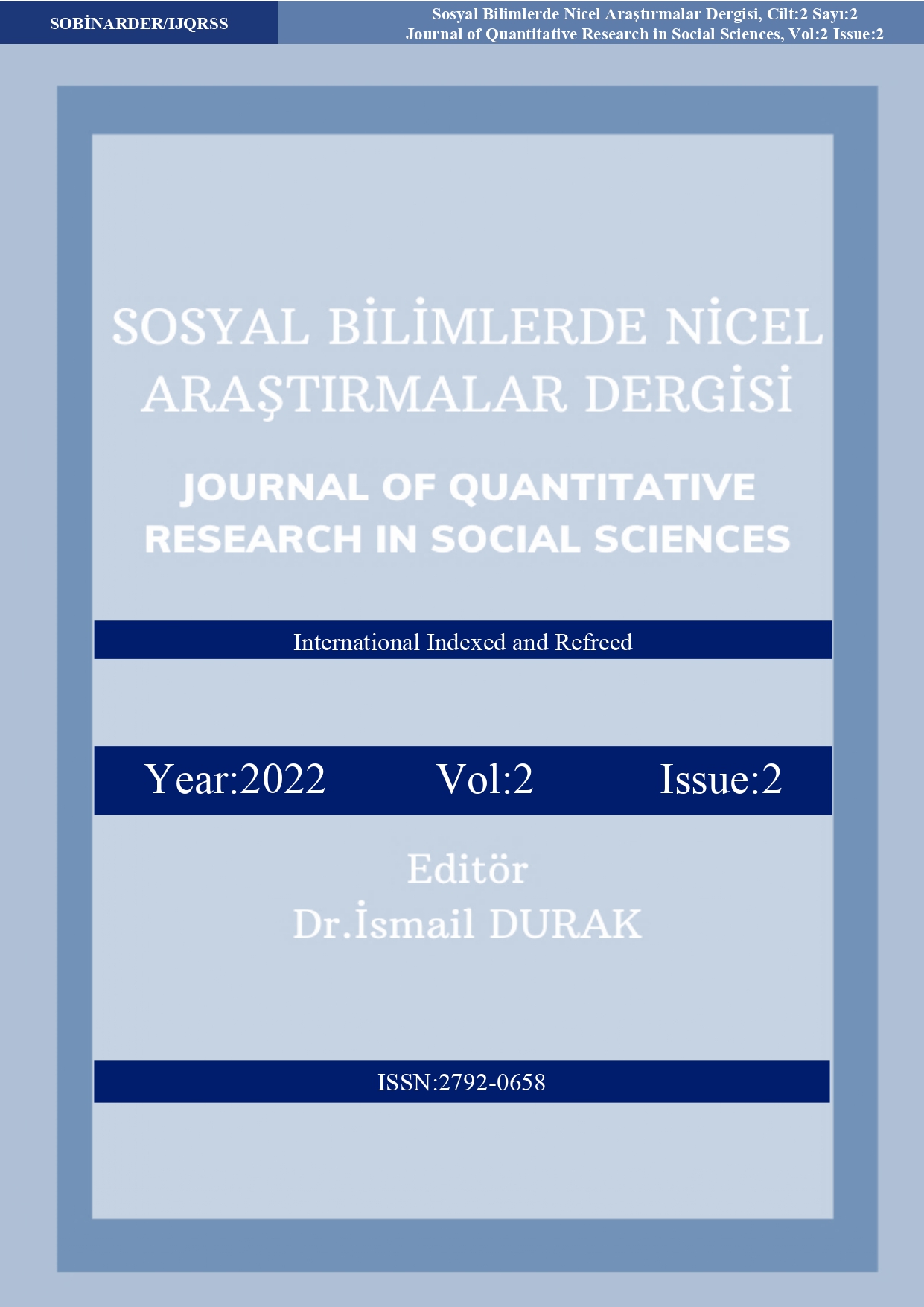Sosyoloji Araştırmaları İçin Nicel Bir Yöntem Önerisi: Sorgulayıcı Veri Çözümlemesi
A Quantitative Method Proposal for Sociological Research: Exploratory Data Analysis
Anahtar Kelimeler:
Sosyoloji- Sorgulayıcı Veri Çözümlemesi- Dal Yaprak- Beşli Özet- Kutu ÇizimÖzet
Sorgulayıcı veri çözümlemesi teknikleri, verilerin yapısı hakkında sağlıklı bilgilerin edinilmesini sağlamaktadır. Bu çerçevede kurulacak olan modeller daha güvenilir olmakta ve daha doğru sonuçlar vermektedir. Sosyoloji araştırmalarında genel olarak nitel değişkenler kullanılmaktadır. Bu çalışmanın amacı, sosyoloji çalışmalarında nicel değişkenlerin kullanımının yaygınlaştırılmasını sağlamaktır. Sorgulayıcı veri çözümlemesi teknikleriyle tüm ölçek tiplerinde derlenen verilerin analiz edilmesi mümkün olmaktadır. Söz konusu tekniklerin sosyoloji araştırmalarında uygulanması önerisi bu çalışmanın temelini oluşturmaktadır. Bu amaçla çalışmada Türkiye’nin boşanma verisi kullanılarak bir uygulama da yapılmış ve teknikler geniş bir çerçevede tartışılmıştır. Uygulamada elde edilen araştırma sorularına yer verilmiş ve çalışmaların kapsamının nasıl genişletileceği konusunda öneriler getirilmiştir.
Referanslar
Arıcı, H. (1988), İstatistik Yöntemleri ve Uygulamaları, Meteksan Yayıncılık, Ankara
Aydın, A. (2021), Türkiye’de İller Arası Gelir Dağılımının Sorgulayıcı Veri Çözümlemesi Teknikleri ile Analizi, İşletme ve İktisat Çalışmaları Dergisi, 9 (2), 104-124
Behrens J.T. (1997), Principles and Procedures of Exploratory Data Analysis, Psychological Methods, 2 (2), pp. 131-160
Bernard, H.R. (2000), Social Research Methods, Sage
Chatfield, C., (1986), Exploratory Data Analysis, European Journal of Operational Research, 23, ss. 5-13.
Cleveland, W. S. (1985), The Elements of Graphing Data, Wadsworth
Cleveland, W. S. (1993), Visualising Data. Hobart Press, AT&T Bell Laboratories.
Cooper, D.R. ve Schindler, P.S. (2003), Business Research Methods, McGraw-Hill
Emerson, J.D ve Strenıo, J. (1983). Boxplots and Batch Comparison, Hoaglin, Mosteller, Tukey (1983) içinde, 97-128.
Haig B.D. (2005), An Abductive Theory of Scientific Method, Psychological Methods, 10 (4), pp. 371-388.
Hartwig, F. & Dearıng, B. E. (1979), Exploratory Data Analysis, Sage University Paper, No: 16
Hoaglın, D.C. (1983), Understanding Robust And Exploratory Data Analysis, Wiley.
Hoaglin, D. C., Mosteller, F. Ve Tukey, J.W. (1985), Exploring Data Tables, Trends, and Shapes. John Wiley
Kurtuluş, K. (1985), Pazarlama Araştırmaları, İstanbul Üniversitesi Yayınları, İstanbul
Leinhardt G. ve Leinhardt S. (1980), Exploratory Data Analysis: New Tools for the Analysis of Empirical Data, Berliner D. (Ed.), Review of research in education, Vol. 8, pp. 85-157
Natrella, M, (2010). NIST/SEMATECH e-handbook of statistical methods. Nist/Sematech, 49.
Orhunbilge, N., Ersoy, M.Ş., Çatalca, H. ve Nişel, R. (1997), Kuramsal ve Uygulamalı İstatistik Terimleri Sözlüğü, Literatür Yayıncılık, İstanbul
Şenesen, Ü. (2007), Sayıların Arkasını Anlamak, Literatür Yayıncılık, İstanbul
Şenesen, Ü. (2015), İktisat Araştırmalarında Sorgulayıcı Veri Çözümlemesi, Ekonomi-tek, 4 (2), 1-23
Şenesen, Ü. (2019), Sorgulayıcı Veri Çözümlemesine Bir Örnek: İllere Göre İşsizlik Oranları, 2008-2013. Çalışma ve Toplum, 1(60), 423-436.
Theus M. ve Urbanek S. (2008), Interactive Graphics for Data Analysis: Principles and Examples, Chapman & Hall/CRC Press
Tufte E.R. (1983), The Visual Display of Quantitative Information, Graphics Press, Cheshire, CT
Tukey, J. W. (1977). Exploratory Data Analysis, Adisson-Wesley.
Tukey, J. W. (1980), We Need Both Exploratory and Confirmatory, The American Statistician, 34 (1), ss. 23–25.
TÜİK (2022), İllere Göre Kaba Boşanma Hızı, Erişim Tarihi: 10 Mayıs 2022
Velleman, P.F., Hoaglın, D.C. (1981), Applications, Basics and Computing of Exploratory Data Analysis, Duxburry Press.
İndir
Yayınlanmış
Nasıl Atıf Yapılır
Sayı
Bölüm
Lisans
Telif Hakkı (c) 2022 Sosyal Bilimlerde Nicel Araştırmalar Dergisi

Bu çalışma Creative Commons Attribution-NonCommercial 4.0 International License ile lisanslanmıştır.
Telif hakkı hakkında










